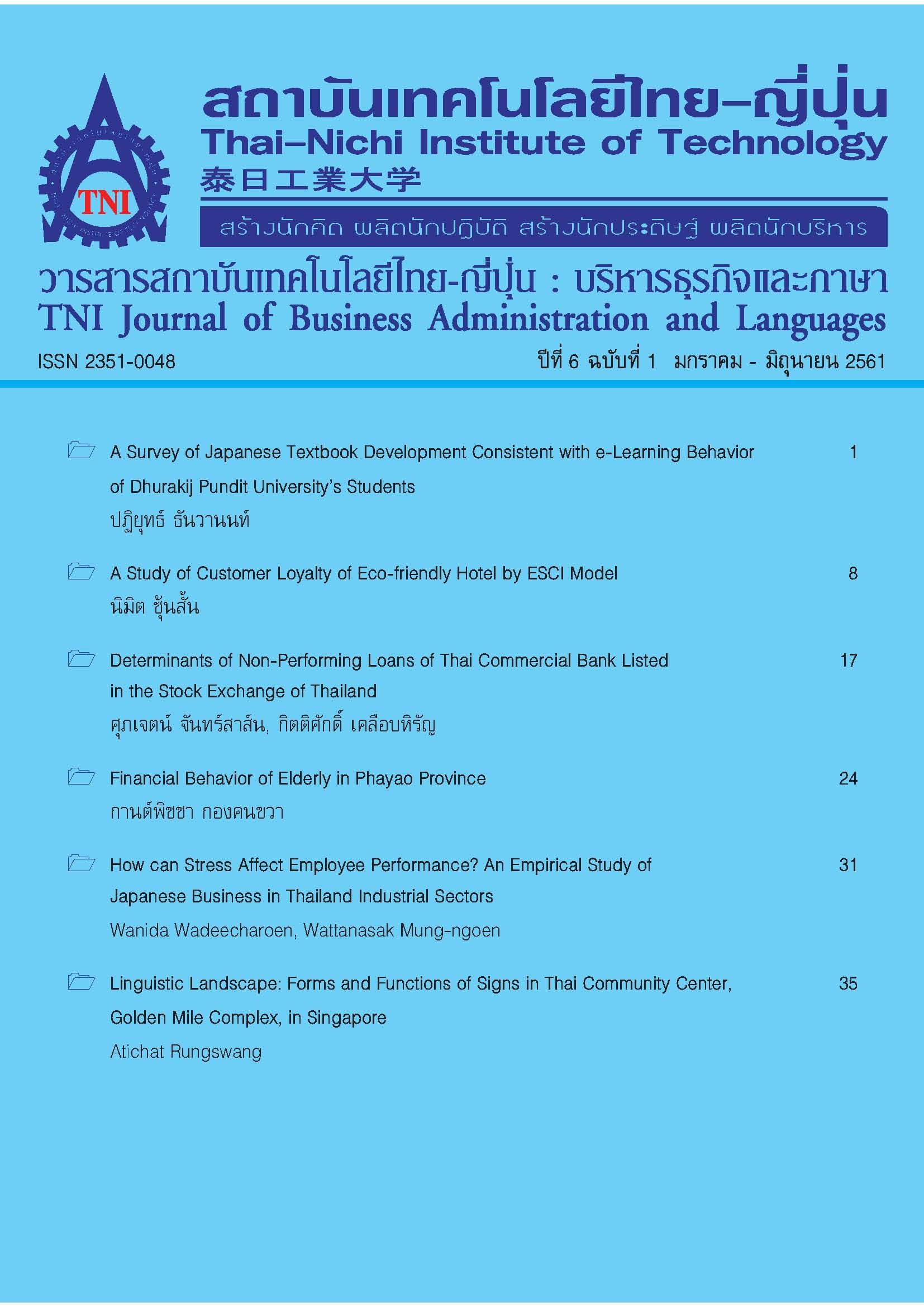The Road to Customer Journey
Main Article Content
Abstract
The twenty-first century is the flourished century with advanced digital technology. Marketing 4.0 is the new concept with customization through business model development that it is driven valued economy with innovation. It is a significant key for any brand to be present path to consumers’ purchase journey. Across the stages of consumers’ purchase journey, there are three stages as the following: pre-purchase, purchase and post-purchase. A marketer ought to understand each stage with deeply study consumer insight and consumer behavior in a wide range of information, consumer choices, consumer decision making process, their lifestyle, including the powerful influencers. A consumers’ purchase journey map is the marketing tool created for explore options and work to build brand awareness in the right channel and time. There are many elements for customer satisfaction in product or service; understanding customer, serve customer as an individual focused on customer-centric, make customer engagement and participation, empower customer, bound customer with product or service and build accessible platforms.
Article Details
Article Accepting Policy
The editorial board of Thai-Nichi Institute of Technology is pleased to receive articles from lecturers and experts in the fields of business administration, languages, engineering and technology written in Thai or English. The academic work submitted for publication must not be published in any other publication before and must not be under consideration of other journal submissions. Therefore, those interested in participating in the dissemination of work and knowledge can submit their article to the editorial board for further submission to the screening committee to consider publishing in the journal. The articles that can be published include solely research articles. Interested persons can prepare their articles by reviewing recommendations for article authors.
Copyright infringement is solely the responsibility of the author(s) of the article. Articles that have been published must be screened and reviewed for quality from qualified experts approved by the editorial board.
The text that appears within each article published in this research journal is a personal opinion of each author, nothing related to Thai-Nichi Institute of Technology, and other faculty members in the institution in any way. Responsibilities and accuracy for the content of each article are owned by each author. If there is any mistake, each author will be responsible for his/her own article(s).
The editorial board reserves the right not to bring any content, views or comments of articles in the Journal of Thai-Nichi Institute of Technology to publish before receiving permission from the authorized author(s) in writing. The published work is the copyright of the Journal of Thai-Nichi Institute of Technology.
References
M. Stickdorn and J. Schneider, This is Service Design Thinking: Basics, Tools, Cases. Hoboken, New Jersey: Wiley, 2012.
S. Miettinen and M. Koivisto, Eds., “Designing services with innovative methods,” in Designing services with innovative methods, Helsinki: University of Art and Design, 2009.
A. R. Hevner, S. T. March, J. Park, and S. Ram, “Design Science in Information Systems Research,” MIS Q., vol. 28, no. 1, pp. 75–105, Mar. 2004.
S. Miettinen and M. Koivisto, “Frameworks for structuring services and customer experience,” in Designing services with innovative methods, Helsinki: University of Art and Design, 2009, pp. 136–149.
M.J. Bitner, A.L. Ostrom, and F.N. Morgan. “Service blueprinting: a practical technique for service innovation,” California Management Review, vol. 50, no. 3, pp. 66-94, 2008.
C.F. Surprenant, and M.R. Solomon. “Predictability and personalization in the service encounter,” Journal of Marketing, vol. 51, no. 2, pp. 86-96, 1987.
L. G. Zomerdijk and C. A. Voss, “NSD Processes and Practices in Experiential Services*,” Journal of Product Innovation Management, vol. 28, no. 1, pp. 63–80, 2011.
B. Stauss, and B. Weinlich, “Process-oriented measurement of service quality: applying the sequential incident technique,” European Journal of Marketing, vol. 31, no. 1, pp. 33-55, 1997.
P. Lillrank, “Service Processes,” in Introduction to Service Engineering, W. Karwowski and G. Salvendy, New York: Wiley, 2010, pp. 338–364.
J. Carlzon, Moments of Truth. New York: Harper Business, 1989.
D. Court, D. Elzinga, S. Mulder, and O. J. Vetvik, “The consumer decision journey | McKinsey & Company.” [Online]. Available: https://www.mckinsey.com/business-functions/marketing-and-sales/our-insights/the-consumer-decision-journey. [Accessed: 5-Jun-2017].
D. C. Edelman and M. Singer, “Competing on Customer Journeys,” Harvard Business Review, pp. 88–94, 96, 98, 100, Nov. 2015.
M. Miller, “SEO & The Zero Moment of Truth,” Search Engine Land, 29-Feb-2016. [Online]. Available: https://searchengineland.com/seo-zero-moment-truth-242692. [Accessed: 2-Jul-2017].
R. S. Russell and C. W. Zobel, “Bringing Service Sciences into the Curriculum,” in Service Science, Management and Engineering: Education for the 21st Century, B. Hefley and W. Murphy, New York: Springer, 2008, pp. 134–140.
T. L. Tuten and M. R. Solomon, “Social Media for Customer Insight,” in Social Media Marketing, 2nd ed., Los Angeles: SAGE Publications, 2014, pp. 265–283.
F. Lemke, M. Clark, and H. Wilson, “Customer experience quality: an exploration in business and consumer contexts using repertory grid technique,” Journal of the Academy of Marketing Science, vol. 39, no. 6, pp. 846–869, Dec. 2011.
N. Kano, N. Seraku, F. Takahashi, & S. Tsuji, “Attractive quality and must-be quality,” The Journal of Japanese Society for Quality Control, vol. 14, no. 2, pp. 39–48, 1984.
P. Found, & R. Harrison, “Understanding the lean voice of the customer,” International Journal of Lean Six Sigma, vol.3, no.3, pp. 251-267, 2012.
“Why is Customer Engagement important?,” Clarabridge. [Online]. Available: https://www.clarabridge.com/
customer-engagement/. [Accessed: 6-Jun-2017].
A. Simanowitz, “Customer Perspectives on Customer Empowerment,” CGAP, 25-Aug-2015. [Online]. Available:https://www.cgap.org/blog/customer perspectives-customer-empowerment. [Accessed: 15-Jun-2018].

